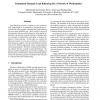Free Online Productivity Tools
i2Speak
i2Symbol
i2OCR
iTex2Img
iWeb2Print
iWeb2Shot
i2Type
iPdf2Split
iPdf2Merge
i2Bopomofo
i2Arabic
i2Style
i2Image
i2PDF
iLatex2Rtf
Sci2ools
HPDC
1996
IEEE
1996
IEEE
Customized Dynamic Load Balancing for a Network of Workstations
Load balancing involves assigning to each processor, work proportional to its performance, minimizing the execution time of the program. Althoughstatic load balancing can solve many problems (e.g., those caused by processor heterogeneity and non-uniform loops) for most regular applications, the transient external load due to multiple-users on a network of workstations necessitates a dynamic approach to load balancing. In this paper we examine the behavior of global vs local, and centralized vs distributed, load balancing strategies. We show that different schemes are best for different applications under varying program and system parameters. Therefore, customized load balancing schemes become essential for good performance. We present a hybrid compile-time and run-time modeling and decisionprocesswhichselects(customizes)thebestscheme, along with automatic generation of parallel code with calls to a runtime library for load balancing.
Althoughstatic Load Balancing | Distributed And Parallel Computing | HPDC 1996 | Load Balancing | Load Balancing Strategies |
| Added | 07 Aug 2010 |
| Updated | 07 Aug 2010 |
| Type | Conference |
| Year | 1996 |
| Where | HPDC |
| Authors | Mohammed Javeed Zaki, Wei Li, Srinivasan Parthasarathy |
Comments (0)

